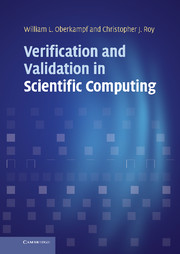Book contents
- Frontmatter
- Contents
- Preface
- Acknowledgments
- 1 Introduction
- Part I Fundamental concepts
- 2 Fundamental concepts and terminology
- 3 Modeling and computational simulation
- Part II Code verification
- Part III Solution verification
- Part IV Model validation and prediction
- Part V Planning, management, and implementation issues
- Appendix Programming practices
- Index
- Plate Section
- References
2 - Fundamental concepts and terminology
from Part I - Fundamental concepts
Published online by Cambridge University Press: 05 March 2013
- Frontmatter
- Contents
- Preface
- Acknowledgments
- 1 Introduction
- Part I Fundamental concepts
- 2 Fundamental concepts and terminology
- 3 Modeling and computational simulation
- Part II Code verification
- Part III Solution verification
- Part IV Model validation and prediction
- Part V Planning, management, and implementation issues
- Appendix Programming practices
- Index
- Plate Section
- References
Summary
This chapter discusses the fundamental concepts and terminology associated with verification and validation (V&V) of models and simulations. We begin with a brief history of the philosophical foundations so that the reader can better understand why there are a wide variety of views toward V&V principles and procedures. Various perspectives of V&V have also generated different formal definitions of the terms verification and validation in important communities. Although the terminology is moving toward convergence within some communities, there are still significant differences. The reader needs to be aware of these differences in terminology to help minimize confusion and unnecessary disagreements, as well as to anticipate possible difficulties in contractual obligations in business and government. We also discuss a number of important and closely related terms in modeling and simulation (M&S). Examples are predictive capability, calibration, certification, uncertainty, and error. We end the chapter with a discussion of a conceptual framework for integrating verification, validation, and predictive capability. Although there are different frameworks for integrating these concepts, the framework discussed here has proven very helpful in understanding how the various activities in scientific computing are related.
- Type
- Chapter
- Information
- Verification and Validation in Scientific Computing , pp. 21 - 82Publisher: Cambridge University PressPrint publication year: 2010



